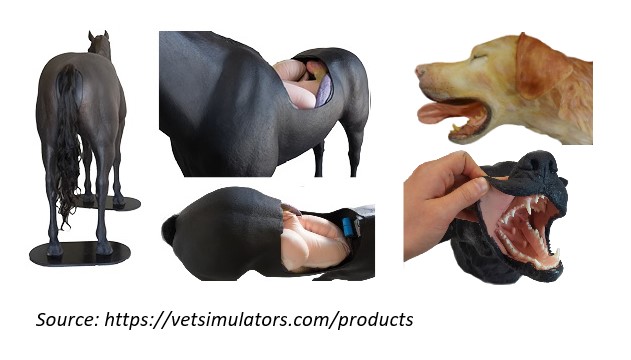Simulators for teaching practical skills to veterinary students
Helen Braid, from Liverpool University, recently published a review describing simulators for the practical teaching of veterinary students. In this article she describes the simulators available, their use, efficiency, and the views of veterinary student about them.
What are simulators?
Veterinary training simulators are devices that mimic the real conditions of veterinary work (i.e., anatomic regions or clinical tasks) and that can help to replace the use of animals for educational purposes. Their use has raised significantly over the last years and will continue to do so in the future as these simulators help to ensure a consistent level of competence in new graduates. It also increases the confidence of students when they then need to perform a procedure on a live clinical case requiring veterinary treatment or intervention.
What are the different types of simulators?
Different types of simulators are used in veterinary schools. They are classified into four categories:
- Model-based practical simulators: these teach practical clinical skills without using animals.
- Practical virtual simulators: these teach practical skills based on virtual reality or augmented reality.
- Non-practical virtual simulators: these deliver theoretical scenarios by using computer software.
- Communication-based/Scenario-based simulators: these provide different communication scenarios to teach communications skills.
How effective are simulators?
The use of educational simulators is an efficient tool to teach non-invasive techniques to students and helps them to improve their practical skills for surgical procedures. However, the implementation of these simulators does not aim to fully replace live animal trainings, because these remain an essential facet for the completion of a veterinarian education. Clinical case animals who really need an intervention can be used for the teaching of such invasive surgical techniques.
What are the benefits of simulators?
The use of simulators provides students with a safe and low-risk environment in which they can practice their skills without concerns regarding animal welfare or pressure from observing parties. Under these conditions, students feel more confident and less stressed before performing a medical procedure. They develop better practical skills and are more likely to provide better and safer care to the animals. The use of simulators not only reduces the number of animals used for educational purposes, but also improves animal welfare.
Sources
- Link to the manuscript: https://journals.sagepub.com/doi/10.1177/02611929221098138
- Other useful publications:
- Skillslab at the University of Gent:


